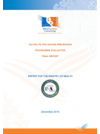Suicide and suicidal behaviour continue to be a major public health issue in New Zealand. Each year more than 500 New Zealanders take their lives and there are over 2500 admissions to hospital for intentional self-harm. The latest statistics in 2012 show that almost one in five completed suicides were Māori suicides and the Māori youth suicide rates were 2.8 times higher than non-Māori youth.
Kia Piki te Ora Māori suicide prevention service (Kia Piki te Ora), operating in nine DHB regions is one element of the social sector’s work towards longer-term goals of reduced suicides, and harm associated with suicidal behaviour in Māori communities.
This recent evaluation report shows that generally stakeholders felt that Kia Piki te Ora’s contribution to Māori suicide prevention worked well when providers engaged with the community. However, the widespread of activities undertaken by the nine providers meant that in some instances stakeholders were unclear on the core role and responsibilities of Kia Piki te Ora.
The evaluation report highlighted some areas for improvement and made five recommendations.
In response to the report, a changed focus and stronger strategic role to strengthen Kia Piki te Ora’s strategic activities through promoting influence with a wider range of community groups will be considered. The proposed changes would help better align Kia Piki te Ora with other agencies working in the same area.
The Ministry has established an advisory group made up of staff from across the Ministry who have expertise in mental health, Māori suicide prevention (with a focus on Māori cultural models of health) and policy and procurement expertise to develop and progress a post evaluation action plan. Information contained in the report has provided the Ministry with a useful stocktake of Kia Piki te Ora activities which will be used to inform the action plan.
The action plan will be aligned with the Ministry’s current policy frameworks as well as taking into account how future Ministry funded Māori suicide prevention services are delivered in areas where there is highest need.
It is expected that the action plan will be completed by early 2016.

